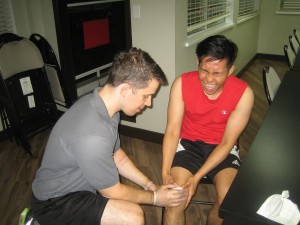Wound irrigation is an essential step in preventing infection after an injury. Irrigation is basically a first aid procedure that is used to wash out debris and bacteria from an open wound. If there are remaining dirt and debris in a particular wound, it will increase the risk for infection to set in. Wound irrigation must be performed as soon as possible after the injury was sustained for the best benefit. Take note that irrigating a wound does not require specialized medical skills and can be easily carried out as long as there is access to clean running water.
Steps on wound irrigation

- Slow down or stop the bleeding before performing wound irrigation. You have to apply light pressure using a clean towel or cloth for 30 minutes until the bleeding stops. If the bleeding could not be controlled, do not attempt to irrigate the wound. You have to bring the individual to the hospital.
- If the bleeding has stopped, you have to use sterile saline solution to rinse the wound. Most of the contact lens solutions in the market are saline solution. Another alternative is to use an unopened bottle of saline nasal spray to irrigate the wound.
- Clean the wound using pressurized tap water if saline solution is not available. You can use a plastic bag and fill it up with tap water. Create a tiny hole in one corner and squeeze the bag slightly to force out the water and onto the wound.
- If a plastic bag is not available, simply run tap water over the wound. It is best to use lukewarm tap water and place the affected area under it for 3-4 minutes. Just make sure to turn the injured part to expose all areas of the wound to the running water.
- Check the irrigated wound for signs of dirt or debris. It is recommended to use tweezers that have been cleansed using alcohol to pick out leftover dirt and debris after wound irrigation has been performed. Do not try to remove deep or embedded debris since only a doctor can remove them without causing further damage to the wound.
- Apply a layer of antibiotic cream or ointment over the wound and cover with a bandage. The antibiotic cream or ointment will keep the wound moist while at the same time minimizing scarring and reducing the risk for infection. Always make sure that the bandage is changed on a daily basis or when it becomes dirty or wet.
Important considerations to bear in mind
Do not use iodine, soap or hydrogen peroxide for wound irrigation. These products will not help clean the wound and will only cause further irritation to the injured tissues. Always watch out for signs of infection including the appearance of red-colored streaks in the skin surrounding the site of injury, pain and warm sensation in the wound. Additionally, if the wound is oozing pus or does not heal, it indicates infection has set in.
